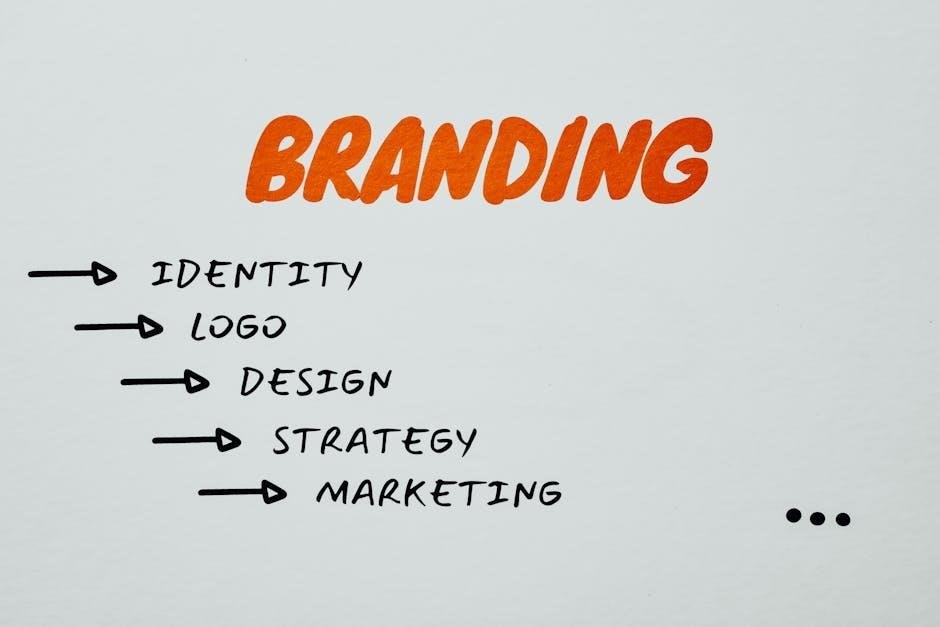the 1 page marketing plan pdf
Summary
Download the 1-Page Marketing Plan PDF and discover how to transform your business strategy. Simple, effective, and proven to drive growth. Get your copy now!

The 1-Page Marketing Plan by Allan Dib offers a simple, customer-focused strategy to attract new customers and grow your business through three clear phases.
What is the 1-Page Marketing Plan?
The 1-Page Marketing Plan, created by Allan Dib, is a concise and structured approach to developing a marketing strategy. It is designed to be simple and easy to implement, focusing on the essential elements of marketing without unnecessary complexity. The plan is particularly beneficial for small businesses, as it provides a clear and actionable framework that can be summarized on a single page. Central to the plan are three key phases of customer engagement: awareness, familiarity, and enthusiasm. These phases guide businesses through the process of attracting new customers, building relationships, and turning them into loyal advocates. The plan emphasizes direct response marketing tactics, which aim to elicit immediate feedback and actions from potential customers. By focusing on clarity and practicality, the 1-Page Marketing Plan helps businesses create effective strategies that drive growth and stand out in a competitive market.
The Importance of a Simple Marketing Strategy
A simple marketing strategy is essential for clarity and effectiveness. It helps businesses avoid overwhelming complexity, allowing them to focus on clear goals and actionable steps. Simplicity ensures that marketing efforts are aligned with the core business objectives, making it easier to communicate value to customers. A straightforward approach also fosters consistency in messaging and execution, which are critical for building trust and recognition. By streamlining strategies, businesses can allocate resources more efficiently and measure results more accurately. Ultimately, simplicity in marketing enables small businesses to compete effectively, driving growth and customer loyalty without unnecessary overhead. The 1-Page Marketing Plan exemplifies this principle, offering a clear and concise framework for achieving marketing success.
How the Plan Helps Small Business Owners

The 1-Page Marketing Plan empowers small business owners by providing a clear, actionable roadmap to attract customers and grow their business. It eliminates the guesswork often associated with marketing, offering a structured approach that saves time and resources. By focusing on three customer-focused phases—awareness, familiarity, and enthusiasm—the plan helps businesses build meaningful relationships with their target audience. It also emphasizes the importance of direct response marketing, enabling owners to track results and optimize their efforts. This simplicity and focus allow small businesses to stand out in a crowded market, generate leads, and convert them into loyal customers. The plan’s templates and step-by-step guidance make it accessible even for those with limited marketing experience, ensuring they can implement effective strategies without complexity.

Key Elements of the 1-Page Marketing Plan
The plan includes three phases: prospecting, lead nurturing, and customer retention, structured into nine key areas for a clear, customer-focused marketing strategy.

Defining Your Ideal Customer Avatar
Defining your ideal customer avatar is crucial for precise targeting. It involves creating a detailed profile of your perfect customer, including demographics, pain points, and goals. This step ensures your marketing efforts resonate deeply, fostering trust and engagement. By understanding your avatar, you tailor messages that address their specific needs, leading to higher conversion rates. It’s about more than just data—it’s about crafting a connection that drives loyalty and advocacy for your brand. A well-defined avatar guides all aspects of your marketing strategy, ensuring clarity and focus in every campaign.
Understanding Marketing Strategy vs. Tactics
Marketing strategy and tactics are often confused but serve distinct roles. Strategy is the overarching plan that defines your long-term goals, target market, and unique value proposition. It provides the direction for all marketing efforts. Tactics, on the other hand, are the specific actions taken to execute the strategy, such as social media campaigns, email marketing, or ads. A clear strategy ensures cohesion, while tactics deliver the actionable steps to achieve it. Understanding this distinction is vital for creating a focused and effective marketing plan. Without a strong strategy, tactics can become scattered and ineffective. Together, they form the foundation for reaching and engaging your ideal customers.
The Three Phases of Marketing: Awareness, Familiarity, and Enthusiasm
The 1-Page Marketing Plan outlines three essential phases to guide customers from initial discovery to loyal advocacy. The first phase, awareness, focuses on introducing your brand to potential customers who may not yet know you exist. This is achieved through targeted messaging and visibility tactics. The second phase, familiarity, builds on awareness by nurturing relationships, providing value, and establishing trust. Finally, the enthusiasm phase transforms satisfied customers into loyal advocates who actively promote your brand. Together, these phases create a structured approach to moving prospects from curiosity to commitment, ensuring a seamless and customer-focused journey.

Phase 1: Prospecting and Lead Generation
Phase 1 focuses on identifying your target market, creating compelling messages, and using direct response tactics to attract and capture high-quality leads effectively.
Identifying Your Target Market
Identifying your target market is the cornerstone of Phase 1 in Allan Dib’s 1-Page Marketing Plan. This step involves defining a specific audience based on demographics, needs, and behaviors. By narrowing down your ideal customer avatar, you ensure that your marketing efforts are focused and effective. The plan emphasizes the importance of avoiding broad, vague targets and instead opting for a clearly defined niche. This precision allows businesses to tailor their messages and strategies to resonate deeply with potential customers, increasing the likelihood of engagement and conversion. Dib’s approach stresses that a well-defined target market is essential for driving growth and maximizing ROI in any marketing campaign.
Creating Compelling Marketing Messages
Creating compelling marketing messages is a critical component of Allan Dib’s 1-Page Marketing Plan. The plan emphasizes the importance of crafting clear, concise, and impactful messages that resonate with your target audience. By understanding your customers’ needs, desires, and pain points, you can tailor your messaging to speak directly to them. The focus should be on the benefits your product or service provides, rather than just listing features. Dib’s approach encourages businesses to use simple, jargon-free language that emotionally connects with potential customers. This ensures your message cuts through the noise and drives action. The plan also highlights the importance of consistency in messaging across all marketing channels to build trust and recognition.
Using Direct Response Marketing Tactics

Using direct response marketing tactics is a cornerstone of Allan Dib’s 1-Page Marketing Plan. These tactics are designed to elicit immediate and measurable responses from potential customers. Strategies like email campaigns, print ads, and landing pages are employed to capture interest and generate leads. Each tactic is crafted with a clear call-to-action, ensuring that customers know exactly what step to take next. The plan emphasizes the importance of tracking responses to refine and optimize marketing efforts. By focusing on direct response, businesses can build a database of interested prospects and nurture them through the sales process. This approach not only drives conversions but also helps establish trust and credibility with your audience, positioning your business as an authority in your industry.

Phase 2: Lead Nurturing and Conversion
Phase 2 focuses on building relationships with leads, providing value through content and offers, and establishing trust to convert prospects into loyal customers.
Building Relationships with Potential Customers
Building strong relationships with potential customers is crucial for converting leads into loyal buyers. This phase focuses on fostering trust and communication through personalized engagement. By understanding your ideal customer avatar, you can tailor your messages to address their specific needs and pain points. Direct response marketing tactics, such as email campaigns and social media interactions, help maintain consistent communication. Providing value through educational content, offers, and insights positions you as an authority in your niche. Trust is built when you deliver on your promises and demonstrate genuine care for your audience. Over time, this relationship evolves from acquaintance to advocate, creating a loyal customer base that drives repeat business and referrals.
Providing Value Through Content and Offers
Providing value through content and offers is a cornerstone of the 1-Page Marketing Plan, helping to nurture leads and build trust. By creating educational and engaging content, such as blog posts, videos, or email campaigns, you address your ideal customer avatar’s needs and pain points. Offers like free resources, discounts, or trials incentivize action and demonstrate your expertise. This approach not only educates potential customers but also positions you as an authority in your niche. Consistent delivery of value ensures that prospects remain engaged, fostering a relationship that naturally progresses toward conversion. Over time, this trust-building process transforms leads into loyal customers who are more likely to advocate for your brand.
Positioning Yourself as an Authority
Positioning yourself as an authority is crucial for building trust and credibility with your target market. By consistently delivering value through high-quality content, such as blog posts, case studies, and webinars, you establish your expertise in your niche. Sharing success stories, testimonials, and proven results further reinforces your authority. This approach helps potential customers see you as a reliable and knowledgeable guide, making them more likely to trust your recommendations and solutions. Over time, this authority status not only attracts more leads but also strengthens customer loyalty and advocacy. Allan Dib emphasizes that authority is built through education and consistency, enabling you to stand out in a crowded marketplace and create lasting relationships with your audience.

Phase 3: Customer Retention and Enthusiasm
Focuses on retaining customers, fostering loyalty, encouraging referrals, and building a community to turn clients into long-term advocates for your brand.
Turning Customers into Loyal Advocates
Turning customers into loyal advocates is about fostering long-term relationships and creating a sense of belonging. Provide exceptional value, deliver on promises, and engage personally to build trust. Encourage customers to share their positive experiences by incentivizing referrals and testimonials. Offer exclusive rewards or early access to new products to make them feel valued. Regular communication and personalized interactions strengthen their connection to your brand. Loyal advocates not only return for repeat business but also actively promote your brand to others, amplifying your reach. This phase ensures sustained growth and a loyal customer base that champions your business for years to come;
Encouraging Referrals and Repeat Business
Encouraging referrals and repeat business is crucial for sustainable growth. Implement referral programs offering incentives for both the referrer and the new customer. Consistently deliver exceptional value to keep customers coming back. Use personalized communication and exclusive offers to reinforce loyalty. Actively seek feedback to improve products and services, showing customers their opinions matter. Build trust through reliable service and transparent communication. Create a community around your brand where customers feel connected. Repeat business and referrals are powerful indicators of customer satisfaction and loyalty, driving long-term success and reducing acquisition costs. By prioritizing these strategies, businesses can foster a loyal customer base that fuels growth organically.
Building a Community Around Your Brand
Building a community around your brand fosters loyalty and advocacy. Create engaging platforms where customers interact, share experiences, and connect with your brand. Use social media groups, forums, or events to cultivate a sense of belonging. Share user-generated content to highlight customer contributions. Offer exclusive rewards or early access to loyal members. Host webinars, workshops, or meetups to educate and entertain your audience. Encourage discussions and feedback to make customers feel valued. A strong community becomes a powerful marketing asset, driving word-of-mouth referrals and sustained engagement. By nurturing these relationships, businesses can create a loyal ecosystem that champions their brand. Community-building is a cornerstone of long-term success in the 1-Page Marketing Plan.

Tools and Resources for Implementing the Plan
The 1-Page Marketing Plan provides a simple template, direct response tactics, and case studies to help businesses implement and optimize their marketing strategies effectively.
The 1-Page Marketing Plan Template
The 1-Page Marketing Plan template is a structured, concise tool designed by Allan Dib, helping businesses map out their marketing strategy in a single, organized document. It divides the plan into nine key sections, guiding users through defining their ideal customer, creating compelling messages, and outlining actionable tactics. This template simplifies complex marketing strategies, making it accessible for small business owners to implement effectively. By filling out each section, users can create a clear, actionable plan tailored to their specific needs, ensuring they cover all essential aspects of their marketing efforts without overwhelming complexity. The template is a cornerstone of Dib’s approach, emphasizing clarity and focus to drive results.
Recommended Reading and Further Resources
Allan Dib’s The 1-Page Marketing Plan is a cornerstone resource for small businesses, offering a step-by-step guide to creating a tailored marketing strategy. For deeper insights, explore Dib’s complementary materials, such as webinars and workshops, which expand on the book’s principles. Additionally, the 1-Page Marketing Plan Template is a must-have tool, providing a structured format to implement the strategies outlined in the book. For advanced learning, consider exploring resources on direct response marketing and customer avatar creation. Case studies from successful implementations of the plan are also available, offering real-world examples of its effectiveness. Finally, online communities and forums dedicated to the 1-Page Marketing Plan provide valuable peer support and shared experiences, helping you refine your approach and stay updated on best practices.
Case Studies and Success Stories
The 1-Page Marketing Plan has empowered numerous businesses to achieve remarkable growth. One notable case study involves a small service-based business that doubled its revenue within six months by focusing on its ideal customer avatar and implementing direct response tactics. Another example is an e-commerce company that increased its customer retention rate by 40% through effective lead nurturing and loyalty programs. These success stories highlight how businesses of all sizes have leveraged the plan’s three phases—awareness, familiarity, and enthusiasm—to transform their marketing efforts. By applying the strategies outlined in the plan, entrepreneurs have consistently reported increased customer engagement, improved conversion rates, and sustainable business growth. These real-world examples demonstrate the plan’s practicality and effectiveness in driving tangible results. Readers are encouraged to explore these case studies for inspiration and actionable insights.

Common Challenges and Solutions
Challenges include understanding the target market and avoiding generic strategies. Solutions involve defining the ideal customer avatar and staying disciplined in execution to achieve focused results.
Overcoming Marketing Strategy Pitfalls
A common pitfall in marketing is prioritizing tactics over strategy, leading to disjointed efforts. Allan Dib’s 1-Page Marketing Plan emphasizes the importance of a clear strategy first. Many businesses fail to define their ideal customer avatar, resulting in generic messaging that resonates with no one. The plan’s structured approach helps avoid this by focusing on specific target markets. Another challenge is overcomplicating marketing efforts, but the plan’s simplicity ensures clarity. By breaking marketing into three phases—awareness, familiarity, and enthusiasm—businesses can systematically guide customers from prospects to loyal advocates. The template also prevents overwhelm by organizing ideas into actionable steps, ensuring consistency and focus; This streamlined approach helps small business owners stay disciplined and avoid common marketing missteps.
Staying Focused on Your Target Market
Staying focused on your target market is crucial for effective marketing. The 1-Page Marketing Plan emphasizes the importance of identifying a specific audience to avoid wasting resources on uninterested prospects. By defining your Ideal Customer Avatar (ICA), you create messaging that resonates deeply, ensuring your efforts are tailored to those most likely to buy. Many businesses fail by trying to appeal to everyone, diluting their impact. The plan’s structured template helps you maintain focus, guiding you to clearly outline your target market’s demographics, needs, and pain points. This clarity enables personalized campaigns that drive engagement and conversions. Regularly revisiting and refining your target market ensures your marketing remains relevant and effective, avoiding the pitfalls of generic, one-size-fits-all strategies. This focus is foundational to the plan’s success in helping small businesses grow efficiently.
Measuring and Optimizing Your Results
Measuring and optimizing your results is essential for the success of your marketing efforts. The 1-Page Marketing Plan emphasizes the importance of tracking key metrics to evaluate the effectiveness of your strategies. By setting clear goals and using direct response marketing tactics, you can easily measure outcomes such as lead generation, conversion rates, and customer retention. Regularly reviewing these metrics allows you to identify what’s working and what needs improvement. The plan encourages continuous optimization by refining your messaging, targeting, and offers based on data-driven insights. This iterative approach ensures your marketing remains effective and aligned with your business objectives. By consistently measuring and optimizing, you can maximize your return on investment and achieve long-term growth. This focus on results-driven marketing is a cornerstone of the 1-Page Marketing Plan’s practical approach.
The 1-Page Marketing Plan provides a clear roadmap for small businesses to attract customers and grow. By implementing the strategies, you can create a tailored action plan and continuously refine your approach for sustained success.
Summarizing the Key Takeaways
The 1-Page Marketing Plan emphasizes clarity and simplicity, breaking down complex marketing strategies into three phases: awareness, familiarity, and enthusiasm. It focuses on identifying a specific target market, creating compelling messages, and using direct response tactics to generate leads. Building relationships through value and positioning yourself as an authority are crucial for conversion and retention. The plan is designed to be actionable, with a template that guides small business owners in implementing these strategies effectively. By following this structured approach, businesses can attract new customers, increase revenue, and build loyal advocates, ensuring long-term growth and success.
Creating an Action Plan for Implementation
Implementing the 1-Page Marketing Plan requires a structured approach. Start by defining your target market and crafting clear, compelling messages. Use direct response tactics to generate leads and build relationships through value-driven content. Focus on positioning yourself as an authority in your niche. Create a timeline for each phase: awareness, familiarity, and enthusiasm. Assign specific actions, such as launching campaigns, distributing lead magnets, and engaging with your audience. Track progress and refine strategies based on results. Continuously optimize your efforts to ensure alignment with your business goals. By following this actionable plan, you can systematically attract, convert, and retain customers, driving sustainable growth for your business.
Continuously Improving Your Marketing Efforts
Continuous improvement is essential for long-term marketing success. Regularly review and refine your strategies based on performance data and customer feedback. Use A/B testing to optimize messaging, tactics, and channels. Stay updated on marketing trends and adapt your approach to remain relevant. Leverage insights from customer interactions to deepen your understanding of their needs. Iterate on your ideal customer avatar and adjust your tactics to better align with their preferences. Celebrate successes and learn from setbacks to refine your process. By fostering a culture of continuous improvement, you ensure your marketing efforts remain effective and responsive to market changes, driving sustained growth and customer engagement.